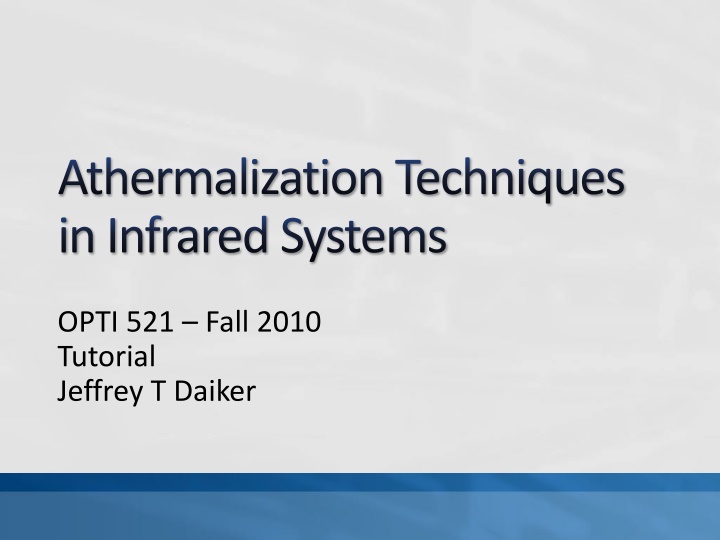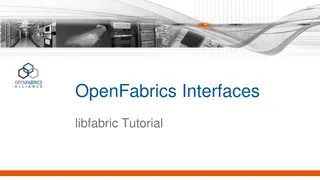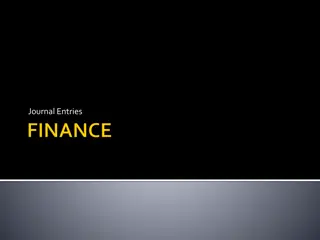
Athermalization Techniques in Infrared Systems Tutorial
Explore the effects of temperature on focus in infrared systems, athermalization techniques, and thermal modeling in this comprehensive tutorial by Jeffrey T. Daiker. Learn about optically passive, mechanically passive, and electromechanically active athermalization methods, as well as the concept of athermal achromats and multiple lens systems. Discover how to mitigate defocus due to temperature changes and effectively model thermal behaviors in ZEMAX software.
Download Presentation

Please find below an Image/Link to download the presentation.
The content on the website is provided AS IS for your information and personal use only. It may not be sold, licensed, or shared on other websites without obtaining consent from the author. If you encounter any issues during the download, it is possible that the publisher has removed the file from their server.
You are allowed to download the files provided on this website for personal or commercial use, subject to the condition that they are used lawfully. All files are the property of their respective owners.
The content on the website is provided AS IS for your information and personal use only. It may not be sold, licensed, or shared on other websites without obtaining consent from the author.
E N D
Presentation Transcript
AthermalizationTechniques in Infrared Systems OPTI 521 Fall 2010 Tutorial Jeffrey T Daiker
Outline Effect of temperature on focus Athermalization of focus Optically passive Mechanically passive Electromechanically active Conclusion References OPTI 521 Fall 2010 Daiker Tutorial 2
Effect of temperature on focus Defocus with temperature change due to the nature of IR lens materials the thermo-optical coefficient of the lens is positive for most IR lens materials and indicates a negative change in focal length with temperature OPTI 521 Fall 2010 Daiker Tutorial 3
Tolerable temperature change Tolerable temperature change for a Ge lens 100 F/4 F/2 F/1 10 delta T (deg C) 1 0.1 0 0.1 0.2 0.3 lens diameter (m) OPTI 521 Fall 2010 Daiker Tutorial 4
Athermalizationoptically passive Combine suitably chosen lens materials which together compensate for thermal defocus Athermal achromat Total power Achromatism Athermalization OPTI 521 Fall 2010 Daiker Tutorial 5
Athermalachromat Example: Si, Ge, ZnS Optimum three-material solution C o n f i g 1 C o n f i g 2 C o n f i g 3 -20 C+20 C +60 C 0 0 . 0 0 0 0 ( d e g ) . 0 4 0 S u r f a c e : I M A L a y o u t C o n f i g u r a t i o n M a t r i x S p o t D i a g r a m U n i t s a r e m . A i r y R a d i u s : 1 9 . 0 2 m T o t a l A x i a l L e n g t h : 1 . 0 1 2 6 8 m m a t o h n e r f m i a g l u a r c h a r t o m i a o t n 2 1 3 6 v o 1 . f Z M 3 X a t o h n e r f m i a g l u a r c h a r t o m i a o t n 2 : 1 6 A v l 1 . l Z M 3 X S c a l e b a r : 4 0 R e f e r e n c e : C h i e f R a y C C OPTI 521 Fall 2010 Daiker Tutorial 6
Multiple Lens Systems Optically passive athermalization very complex Zoom lens is extreme case where completely passive athermalization generally not possible Utilize optical design software OPTI 521 Fall 2010 Daiker Tutorial 7
Thermal Modeling in ZEMAX Before doing any thermal modeling Set TCE of air spaces OPTI 521 Fall 2010 Daiker Tutorial 8
Thermal Modeling in ZEMAX Built-in tool in the Multi-Configuration Editor Add different temperature configurations OPTI 521 Fall 2010 Daiker Tutorial 9
Thermal Modeling in ZEMAX MCE should look something like this OPTI 521 Fall 2010 Daiker Tutorial 10
Athermalizationin ZEMAX Carefully construct merit function Minimize RMS wavefront between two temperatures, for example Optimization using glass substitution Create a glass catalog from a short list (Si, Ge, ZnS, ZnSe, MgO, KRS5, AMTIR1, CaF2 for 3-5 microns) No guarantee solution is global optimum Use design practices, experience, and resources OPTI 521 Fall 2010 Daiker Tutorial 11
Athermalizationmechanciallypassive Involves some method of moving a lens element or elements by an amount that compensates for thermal defocus By using two different materials with very different TCE arranged as either differential expansion cylinders or rods, it is possible to move the compensating element directly Rods or cylinders must be of sufficient length OPTI 521 Fall 2010 Daiker Tutorial 12
Differential expansion Combine spacers of length L1 and L2 with TCE 1 and 2 respectively, then to athermalize over distance L Using materials with > 0 requires L < 0 OPTI 521 Fall 2010 Daiker Tutorial 13
Athermalizationelectromechanically active Relies on compensator elements driven in a temperature controlled manner using information from separate temperature sensors Brute force solution Most suitable for complex systems such as zoom lenses where an electomechanical focus mechanism already exists OPTI 521 Fall 2010 Daiker Tutorial 14
Avoidance of the Problem Example: all-reflective system consisting of aluminum mirrors in an aluminum housing OPTI 521 Fall 2010 Daiker Tutorial 15
Conclusion Optically passive Mechanically passive X Electromechanically active X X X Depends on technique Depends on components Heavy Single FOV Dual FOV Zoom Performance X Very good Good Reliability Very good Fair to good Weight Very light Can be heavy and bulky Power requirements Environmental stability Ease of maintenance Excellent Cost X Concerns under vibration Fair to good Expensive Very good Good Good Fairly cheap Cheap OPTI 521 Fall 2010 Daiker Tutorial 16
References 1. Povey, V. Athermalisation Techniques in Infra Red Systems, Proc. of SPIE Vol. 0655, Optical System Design, Analysis, and Production for Advanced Technology Systems, ed. Fischer, Rogers (Apr 1986) Rogers, P. Athermalization of IR Optical Systems, Critical Review Vol. CR38, Infrared Optical Design and Fabrication, ed. R. Hartmann, W.J. Smith (Apr 1991) Jamieson, T. Athermalization of optical instruments from the optomechanical viewpoint, Critical Review Vol. CR43, Optomechanical Design, ed. P.R. Yoder, Jr. (July 1992) Rayces, J. Thermal compensation of infrared achromatic objectives with three optical materials, SPIE Vol. 1354, International Lens Design Conference (1990) Riedl, M. Optical Design Fundamentals for Infrared Systems, tutorial texts in optical engineering; v.TT20, SPIE Rogers, P. Thermal Compensation Techniques, Handbook of Optics, Volume I, Part 9, Chapter 39. McGraw-Hill, 1995. Zemax Knowledge Base. 2010. http://www.zemax.com/kb/articles/106/1/How-to- Model-Thermal-Effects-using-ZEMAX/ 2. 3. 4. 5. 6. 7. OPTI 521 Fall 2010 Daiker Tutorial 17






















